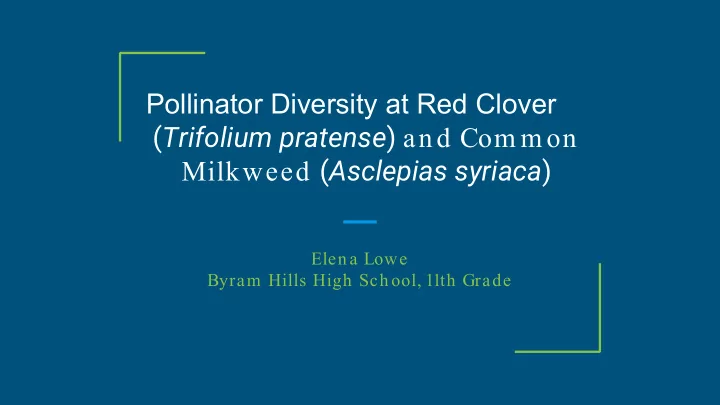

Pollinator Diversity at Red Clover ( Trifolium pratense ) and Com m on Milkweed ( Asclepias syriaca ) Elena Lowe Byram Hills High School, 11th Grade
Background Information ● Plants that bloom at the same time frequently share pollinators (Carvalheiro et al. 2014) Two plants that share pollinators can sometimes compete for pollinators or ● one plant can facilitate the other in increasing pollinator visitation (Carvalheiro et al. 2014)
Vocabulary Native = naturally occurring in the area ● Non-native = introduced outside of natural range ● ○ *Not all non-natives are invasives Naturalized plant = non-native plant that reproduces and maintains itself ● without human help Richness = number of species ● ● Diversity = variety and relative abundance
Vocabulary - Continued ● Competition - in this context, competition means that pollinators are drawn away from one plant species by the presence of a different plant species (Carvalheiro et al. 2014) Facilitation - in this context, facilitation means pollinator visitation to a plant ● species is increased by the presence of a different plant species (Carvalheiro et al. 2014)
Questions Does the richness of aerial insect pollinators on each study species (red ● clover or common milkweed) differ when the species is isolated from the other study species vs. found in a plot with the other study species? ● Do red clover and common milkweed compete for pollinators or facilitate each other in attracting pollinators?
Study Site and Organism s ● Study site: A managed meadow at Cliffdale Farm Red Clover ( Trifolium pratense ) ● Non-native/naturalized, herbaceous perennial ○ Native range: Eurasia and northern Africa ○ Many types of insects visit the flowers ○ ○ Blooming period: late spring - mid-summer
Study Site and Organisms - Continued Common milkweed ( Asclepias syriaca ) ● ○ Native, herbaceous perennial Many types of insects visit the flowers ○ Blooming period: early summer - mid-summer ○
Hypothesis As plant species with overlapping blooming seasons, red clover ( Trifolium pratense ) and common milkweed ( Asclepias syriaca ), share pollinators. Therefore red clover influences the richness of pollinators that visit common milkweed and common milkweed influences the richness of pollinators that visit red clover.
Methods ● Independent variable: whether the species (red clover or common milkweed) is isolated from or found with the other study species (red clover or common milkweed) Response variable: richness of aerial insect pollinators ●
Methods - Continued ● One (1) one-meter by one-meter plot of each of the three treatments (total of 3 plots) - measured with quadrat Similar sunlight at each plot ● At least 6 meters between each plot (Herron-Sweet et al . 2016) ●
Methods - Continued Keep still for two minutes before observation period ● ● While observing, be as still as possible Observe each plot for two observation periods of ten minutes each ● Count each aerial pollinator visit (see insect landing on or hovering over a ○ flower) Do not count insects that are already on flowers before observation time ○ begins (did not see them land)
The study site: A managed meadow at Cliffdale Farm ● Full sun Herbaceous plants ●
Methods - Plots 1. Red clover (RC) only plot (At least about 6 m from common milkweed) a. ~50% red clover cover b. 0% common milkweed cover
Methods - Plots 2. Common milkweed (CMW) only plot (At least about 6 m from red clover) a. ~25-50% common milkweed cover b. 0% red clover cover
Methods - Plots 3. Mixed Flowers (MF) plot: Red clover and common milkweed MF2 Plot MF1 Plot ~25-50% red clover cover ~25-50% red clover cover ~10-25% common milkweed cover ~10-25% common milkweed cover
Results
Results
Results
Results
Discussion / Conclusions ● Research on pollinator behavior relevant today Relationship between plot types appears to vary between each pollinator ● group studied Richness of species not very affected by varying plot type ● Interesting suggestions in data (butterflies on red clover, decreases in ● pollinator counts on common milkweed from CMW to MF plot, totals), but not conclusive evidence
Discussion / Conclusions - Continued ● Problems encountered Wilting flowers ○ ○ Had to switch MF plot on last day of observations due to very wilted milkweed flowers ○ Time constraint ● Future research Repeat on larger scale - more plots, more trials ○ ○ Investigate with more specific taxonomic categories ○ Does the presence of common milkweed cause more butterflies to visit red clover? ○ Is facilitation and/or competition occurring here?
Discussion / Conclusions - Continued ● Relationships between each plot type appeared to be dependent on the pollinator category More research is necessary to draw more solid conclusions for my ● questions
Acknowledgements Thank you to Dr. Amy Karpati, Eva Thaddeus , Charles Luisi, and Erin Baker for helping me with this project .
Recommend
More recommend